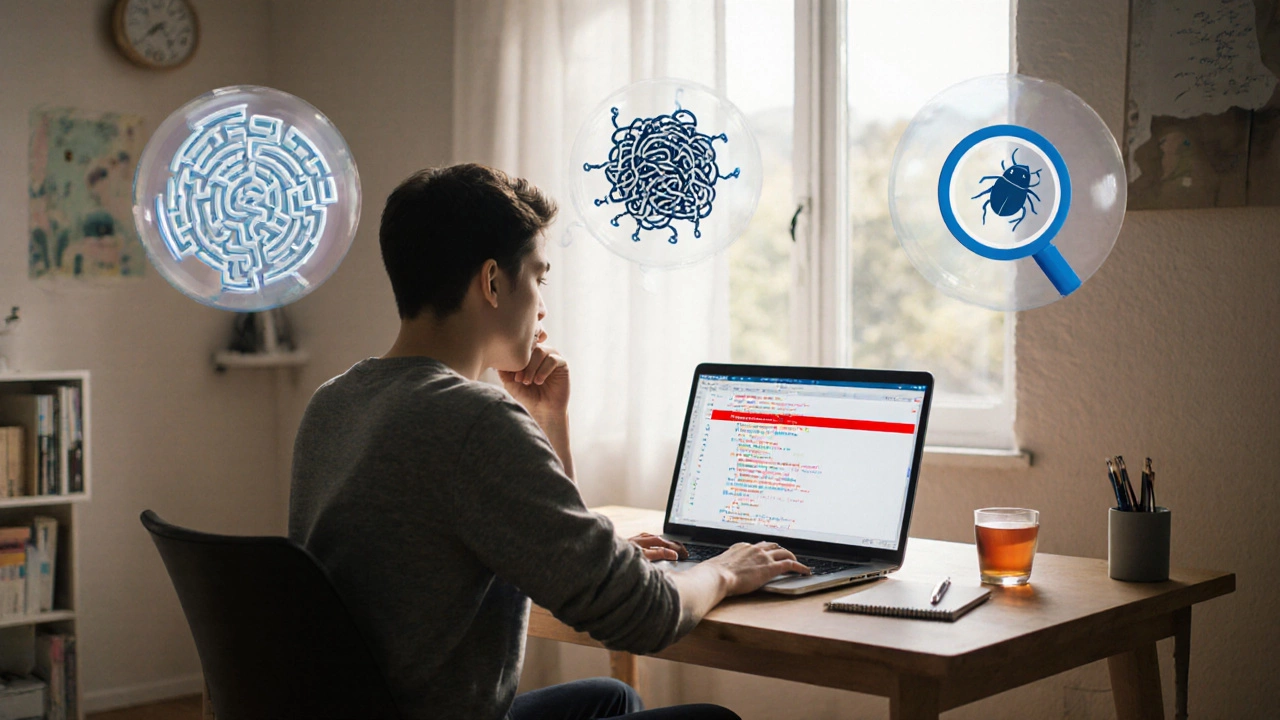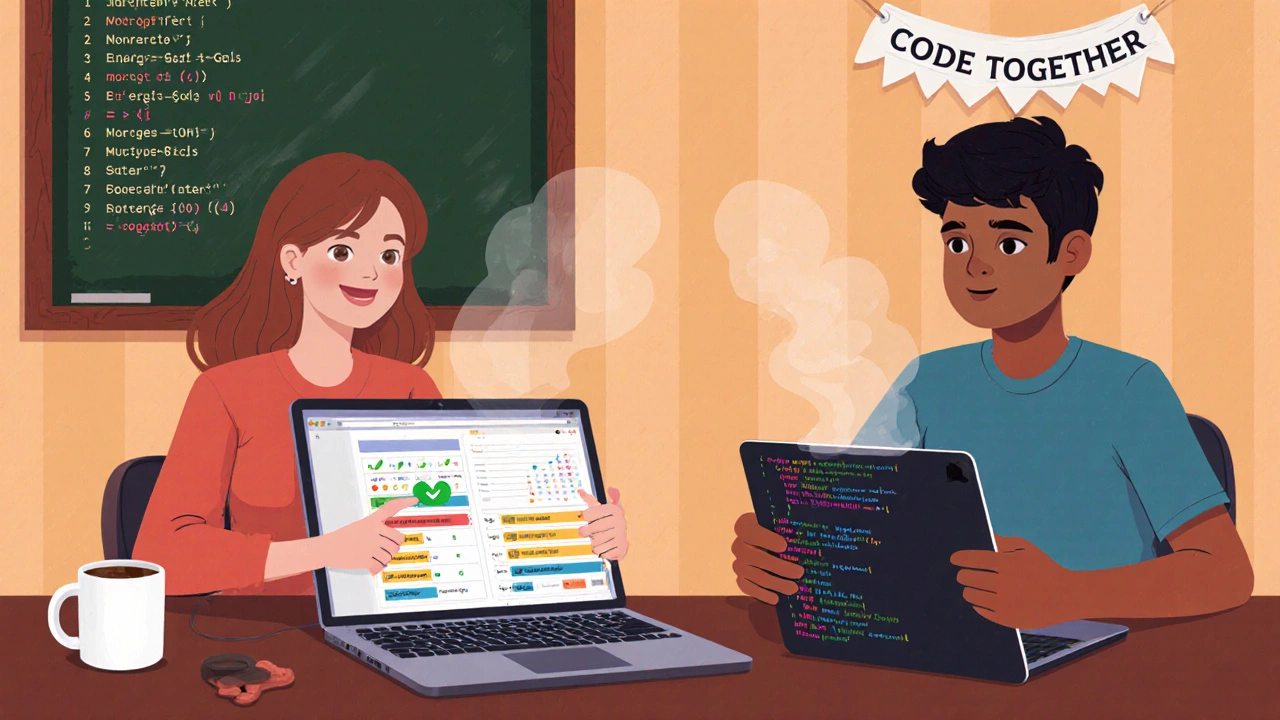
Beginner Coding Roadblock Checker
This tool helps you identify which aspects of coding might be challenging for you and suggests strategies to overcome them.
Your Personalized Roadblock Report
Recommended Learning Path
Python
EasyGreat for beginners due to readable syntax and extensive resources.
JavaScript
MediumExcellent for web development with immediate visual feedback.
Java
HardBest for enterprise applications but has a steeper learning curve.
Pro Tips for Success
Key Takeaways
- Most newcomers hit three core roadblocks: abstract logic, syntax details, and debugging confidence.
- Choosing a beginner‑friendly language like Python can shave weeks off the early learning curve.
- Hands‑on tools (IDE, interactive tutorials, code‑playgrounds) dramatically boost retention.
- Chunked practice, peer support, and early project‑based milestones turn frustration into progress.
- Expect a 3‑6 month plateau; push through with focused micro‑goals and you’ll see steady improvement.
What "Hard" Really Means in Coding
When you hear people say coding is "hard," they’re usually talking about three things: thinking like a computer, memorising syntax, and fixing bugs before they break everything. These aren’t mystical obstacles; they’re skills you can train.
For most beginners, the first two hurdles feel steep because they require a shift from everyday problem‑solving to algorithmic thinking. The third-debugging-often feels like detective work without a clue. Understanding that difficulty is normal helps you set realistic expectations.
Core Concepts That Trip Up New Coders
Algorithm is a step‑by‑step recipe a computer follows to solve a problem. Grasping algorithms means learning to break a task into tiny, ordered actions. Many beginners try to jump straight to code, skipping this mental mapping, and end up tangled in loops that never end.
Logic the set of rules that dictate how statements combine to produce true or false outcomes is another hidden stumbling block. If you never wrote a truth table or practiced conditional statements in everyday life, the idea of "if‑else" can feel alien.
Debugging the systematic process of locating and fixing errors in code is often called the "pain point" because it forces you to read your own instructions line by line, looking for the tiniest typo that stops the whole program.
Choosing a Beginner‑Friendly Language
Not all languages are created equal for newcomers. Below is a quick side‑by‑side look at three popular options.
| Aspect | Python | JavaScript | Java |
|---|---|---|---|
| Syntax simplicity | Very low - uses plain English keywords | Low - curly braces, but forgiving | High - strict typing, verbose |
| Immediate feedback | Interactive REPL (IDLE, Jupyter) | Browser console, Node.js | Requires compilation step |
| Community resources | Huge for data, web, automation | Massive for web front‑end | Strong enterprise support |
| Steepness of learning curve | Gentle - ideal for first 3 months | Moderate - good after basics | Steep - best after prior coding |
For absolute beginners, Python a high‑level, interpreted language known for readable syntax often leads to the smoothest start. Its clear syntax reduces "syntax error" anxiety, letting learners focus on logic first.
Tools That Turn Frustration Into Flow
Using the right environment can shave hours off your learning time.
- IDE Integrated Development Environment that bundles code editor, debugger, and build tools - examples: VSCode, PyCharm Community, or the lightweight Sublime Text.
- Code Playground Browser‑based sandbox for instant code execution - try Replit, CodePen (JavaScript), or Google Colab (Python).
- Interactive Tutorial Step‑by‑step lessons that give you immediate feedback - free options include freeCodeCamp, Codecademy’s basic track, and The Odin Project.
Pick a tool that shows you results instantly. When you see a green checkmark right after typing a line, the brain links effort with reward, cementing the concept.
Learning Strategies That Actually Work
Instead of "watch a 10‑hour video and code later," try these proven habits.
- Micro‑goals: Write a single function a day. One line of code is less intimidating than a whole app.
- Pair programming: Team up with another learner; you explain while they write, and vice‑versa. Teaching reinforces understanding.
- Project‑first approach: Pick a tiny project (to‑do list, weather fetcher) and learn only the pieces you need to finish it.
- Regular debugging drills: Intentionally insert errors and practice reading stack traces. This builds confidence for real bugs.
- Community participation: Join Discord servers, Reddit’s r/learnprogramming, or local Wellington meet‑ups. Real‑world questions expose gaps you didn’t know you had.

Real‑World Stories: From Zero to First App
Emma, a 27‑year‑old retail manager from Wellington, started with zero tech background. She chose Python because her local library offered a beginner’s workshop. Within two months, she built a simple inventory tracker that saved her team 3hours each week. She credits daily 20‑minute code sprints and using VSCode’s built‑in terminal for the breakthrough.
Raj, a 19‑year‑old high‑school graduate, tried JavaScript first, attracted by the promise of instant web results. He struggled with async concepts, hit a three‑month plateau, then switched to Python for a data‑analysis side project. The change in language reduced syntactic noise, letting him concentrate on problem‑solving again.
Both stories highlight a pattern: start simple, stay consistent, and lean on a supportive community.
Checklist: Are You Ready for the Next Step?
- Have you selected a beginner‑friendly language (preferably Python) and installed an IDE?
- Do you have at least one interactive tutorial bookmarked?
- Is a small, tangible project defined (e.g., calculator, notes app)?
- Are you part of a coding community where you can ask questions weekly?
- Do you schedule a consistent practice window (15‑30minutes daily)?
If you can answer “yes” to most of these, you’re positioned to move past the initial "hard" phase and into steady growth.
FAQs
How long does it usually take to feel comfortable coding?
Most people report a noticeable confidence boost after 3‑4 months of daily practice. The exact timeline varies with prior logical experience and the amount of time dedicated each week.
Is Python really easier than JavaScript for absolute beginners?
Yes. Python’s syntax mirrors plain English, has no curly braces, and offers an interactive REPL. JavaScript adds concepts like the event loop early on, which can increase cognitive load.
What are the most common mistakes beginners make?
Skipping the algorithm step, copying code without understanding it, and giving up after the first debugging session. Consistent small goals and active problem‑solving prevent these pitfalls.
Do I need a powerful computer to start learning?
No. Most beginner IDEs and code playgrounds run comfortably on modest laptops or even tablets. Cloud‑based environments like Replit eliminate hardware constraints.
How can I stay motivated when I hit a debugging wall?
Treat the bug as a puzzle: isolate the line, read the error message, and search the exact phrase on Stack Overflow. Celebrate each tiny fix, and remind yourself why you started the project.
In short, coding is hard at first because you’re learning a new way to think. But with the right language, tools, and mindset, the steep part flattens quickly. Grab a simple project, set a tiny daily goal, and join a community-then watch the "hard" become just another step on your learning journey.
More Articles

Is Google Classroom Being Discontinued? The Real Story for 2025
Rumors are swirling about Google Classroom being discontinued, but what’s really happening in 2025? This article digs into Google’s plans, how schools and teachers are reacting, and what changes might affect your online classes. We’ll sort fact from fiction and share tips on how to keep your lessons running smoothly. There’s a lot of confusion out there—let’s cut through it and give you the info you actually need.


